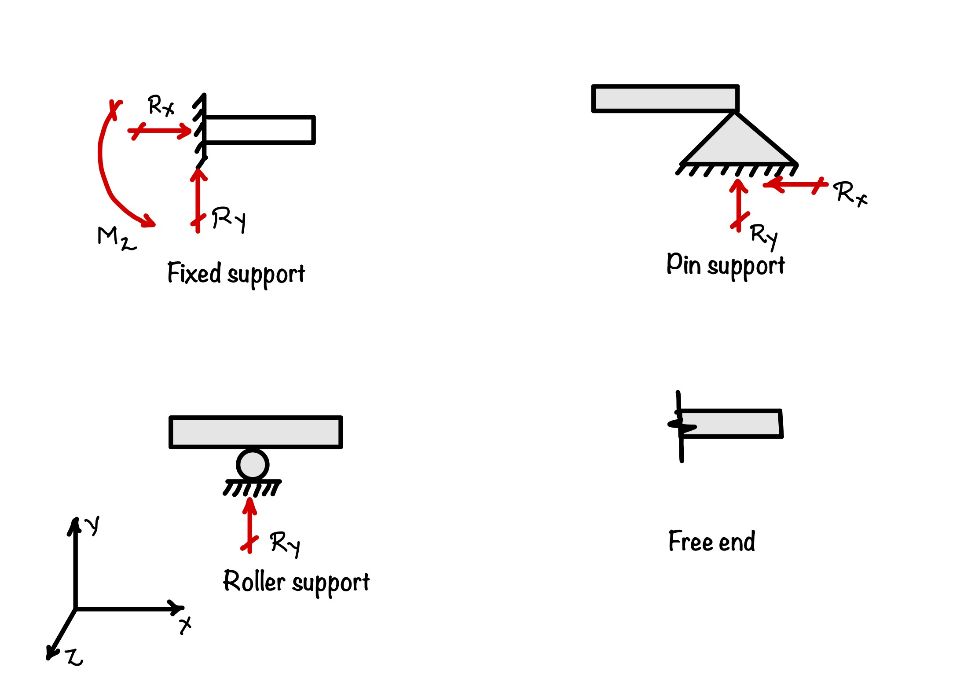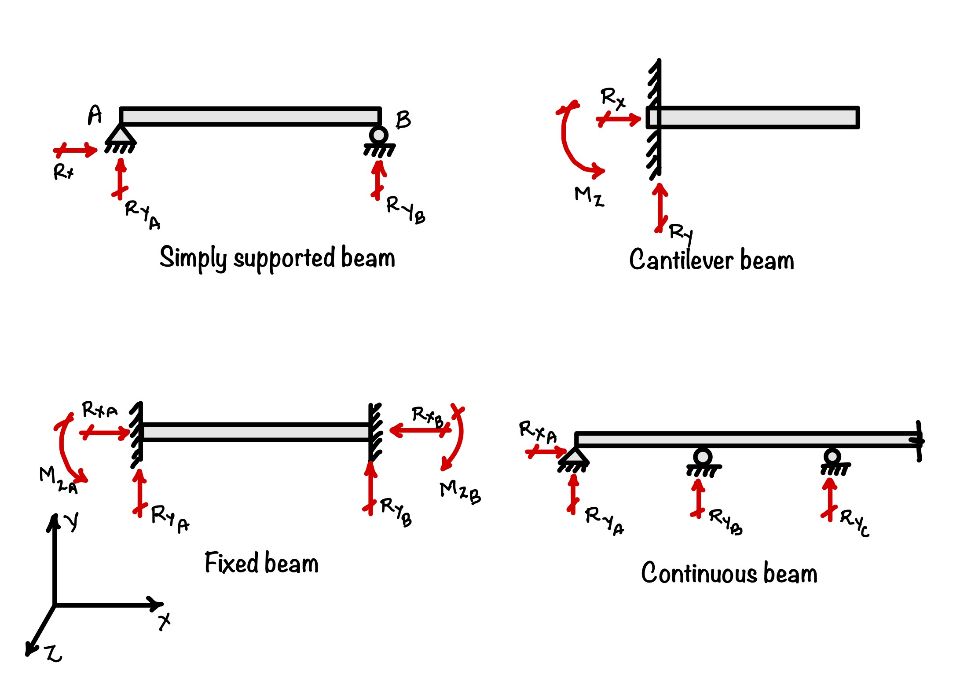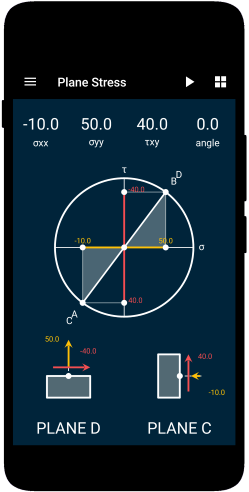To properly analyze a structure, it’s essential to have a good understanding of the different types of supports and the reactions they provide. This information is crucial for drawing an accurate Free Body Diagram (FBD) of the structure. Different types of supports can produce different reactions, so it’s important to know which type of support is being used in order to accurately calculate the forces and stresses involved. In addition to discussing the various types of supports, we’ll also explore some special conditions that can arise in beam structures, which may be relevant in certain unique circumstances.
What are the different types of supports and their reactions in structure?

Different types of support are as follows:
- Simple Support – In mechanics, simple support is a type of support that can only resist forces in the vertical direction. This type of support is often used in trusses and other structural elements. It is important to understand the limitations of simple support when designing a system, as the support may not be able to handle forces in other directions.
- Fixed Support: A fixed support is a type of support that can resist forces in all directions. We use fixed beams generally in the frames and other structures where we need more stability.
- Roller Support: Finally, roller support is a type of support that can resist forces in the horizontal direction. This type of support is often used in bridges and other structures that require the ability to move in one direction.
What are the different types of beams?
For easy reference, different types of support combinations have different names.

Some most popular names of the beams are as follows:
- Simply supported beam:When we place the beam between the one pin support and one roller support, we call it a simply supported beam.
- Cantilever beam: You can refer to part 2 of the figure, it has one end free, and the other fixed support. We call this type of beam as cantilever beam.
- Fixed beam: When we fix the beam from both side. These beams are redundant and known as a statically indeterminate beams. we need one extra condition other than equilibrium to analyze these types of beams.
- Continuous beam: When the beam is continually supported on the support, we call it a continuous beam.
- Propped cantilever: When we provide extra support at the free end of the cantilever beam, call it a propped cantilever beam.
What are the special releases in the structure?
These are the special-purpose release provided in the beam for some special requirements.

Different types of release in the beams are as follows:
- Shear release: These are the release that makes shear force zero at the point. You can refer figure to see the drawing and how we have presented it in the diagram.
- Moment release: As the name suggests, these will make moments at a point zero. That means from this point moment we can not transfer from one side to another side of the beam.
- Thrust release: Yes, you are getting it right. This release allows the axial force to be equal to zero.
What are the terminologies in the structure?
As we have discussed earlier, the structure’s main purpose is to transfer the load to the ground. To do this, we have different types of structures in our vault.
Different types of structures with unique properties are as follows:
- Bar: When we apply the axial tension in the member we make it bar. The bar resists the load by axial elongation. The bar is always in tension.
- Beam: We call those members a beam that supports the load by flexure action. These we can call flexure members.
- Column: These members support axial compression. Or that member who supports the load by compression we call it a column.
- Frames: These are the combination of beams and columns.
- Arches: They resist the load by taking compression. Arch never takes tension.
- Cable: Cables always take tension. When the cable is under compression, it fails.
Conclusions
In this blog post, you have learned the different types of basic terminologies used in structural mechanics. These are very important for beginners in the domain. To understand the mechanics, you need to understand the basic terminologies.
In this post, you have learned the following key concepts :
- Supports: There are different types of supports in our structural mechanics. This support provides different types of reactions. According to the requirement of the condition we generally use them. Fixed support, pinned support, roller support are the few examples.
- Beams: We have also named the rays depending on the different support conditions. Simply supported beams, cantilever beams, fixed beams and continuous beams are the dew examples.
- Structural forms: You are familiar that we have divided the different types of structures based on how they resist the load. Different structural forms are bars, beams, columns, cables, arches, and frames.
Solid Mechanics
In this app, you would be able to explore the world of Solid Mechanics. The app covers many important topics in the field of solid mechanics.
- Interactive Mohr’s Circle of Stress and Strain.
- Calculators for Stress and Strain Analysis.
- Graphical representations of failure criteria.
- A detailed description of key concepts of Solid Mechanics with diagrams.

This article was crafted by a group of experts at eigenplus to ensure it adheres to our strict quality standards. The individuals who contributed to this article are:
Author


